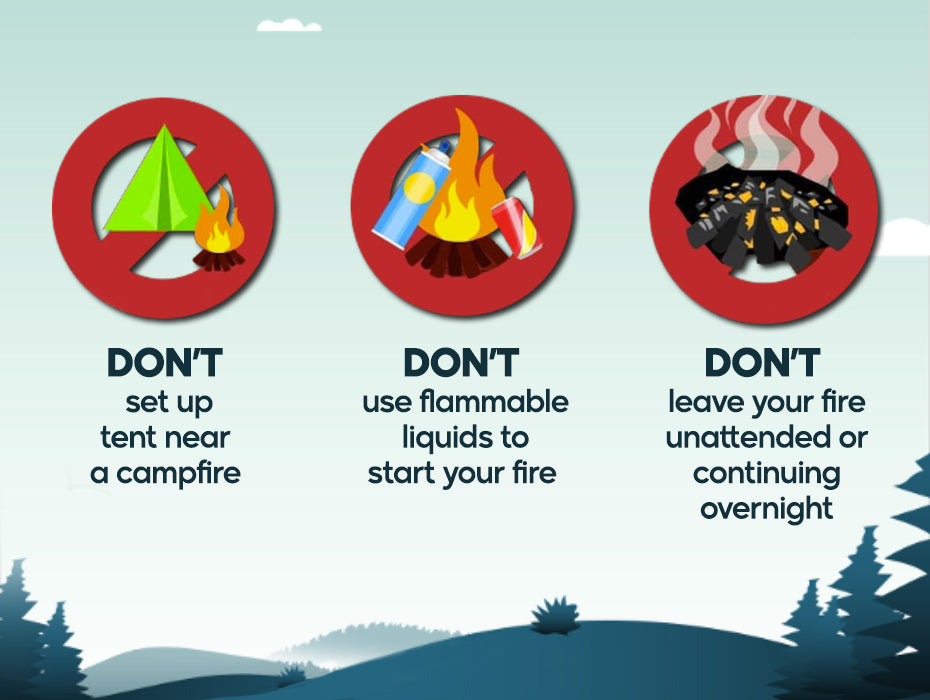No Products in the Cart
Ruth Das -11 July 2022
Fire safety for camping
Enjoying the pop and hiss of a glowing campfire—not to mention the light and warmth that the fire provides—is one of the most enjoyable parts of camping. Making chaisu or BBQ chiken in the wilderness with your loved ones is an amazing feeling, but that feeling comes with responsibility.

Acampfire that is not properly built, maintained, and extinguished can quickly become a hazard to the people, animals, and land around it. It's important to understand how to safely and responsibly enjoy your campfire.
Build a safe campfire and use a Pit !
Once your pit is in place, build a safe campfire. Start the fire with dried leaves or grass that will easily catch fire. Next, add kindling, small twigs, and sticks less than an inch in diameter. Most campgrounds provide a fire pit or fire ring in which to build a campfire. If a pit is provided, this is the only place you should build a campfire. If you're in a remote area where campfires are allowed but a pit is not provided, dig a fire pit in an open area away from overhanging branches, power lines, or other hazards that could catch on fire. Once the pit has been dug, circle the pit with rocks, ensuring there is a ten-foot area around the pit that is cleared of anything that could catch on fire.
Do's and Don'ts while fire safety camping!
Before you strike a match, make sure you know the fire regulations of the area in which you are planning to build a fire

Do's
1. Do build a fire pit on gravel or dirt
Instead of grass, and make sure it is away from trees, shrubs, and low-hanging branches. Campfires should be at least 25 feet away from structures, trees or anything that can burn.
2. Do use a fire ring.
Use fire rings, rocks, or bricks to encircle the fire pit to keep the fire from spreading or getting too big.
3. Do keep a close eye on children around campfires.
Never let children or pets play or stand too close around the fire. You can draw a “safety circle” about 6 feet around the fire pit to visibly show kids the line they can’t cross.
4. Do have a bucket of water or a fire extinguisher on standby
In the unfortunate case that may get the flames to get too big. If you just need to lower the flames, use a shovel, or throw dirt on the fire.
5. Do keep flammable objects away from the fire.
Keep flammable objects away including wood, clothing, or aerosol cans as these can catch fire easily when placed too close to a fire.
6. Do bring a first-aid kit and fire extinguisher
In case of a fire emergencyor to simply deal with bruises and cuts.

Don'ts:
1. Never use gasoline
Gasoline or other flammable, combustible liquids can evaporate and spread faster than you can perceive, use a reccomeded fire starter kit to start or accelerate a fire.
2. Don't have a campfire on windy, dry days.
It’s easier for fires to spread in these conditions as the air is dry.
3. Don’t wear flammable fabrics, such as cotton blends, rayon, nylon, and acrylic.
Stray embers can easily ignite and burn rapidly. Also, tightly fitted clothing is safer when cooking and tending to the fire.
4. Don’t allow kids to roast hot dogs or marshmallows without supervision.
Also, make sure the cooking tool is long enough so kids can stand at a safe distance from the fire.
5. Don’t ever leave a campfire unattended.
If you’re ready to leave, put out the fire completely using a fire extinguisher, water, or dirt. Also, be sure to stir the ashes and embers to ensure another fire won’t start. Embers can remain hot up to 12 hours after a fire has been put out
When cooking, keep a fire extinguisher within reach, find here how to use a fire extinguisher!
ABC Powder is made up of Mono-ammonium phosphate mixed with other powders. Which are also widely used in the fertilizer industry (talk about multitasking). They are non toxic and fully safe to you!
It's better to be safe than sorry! So take the first step towards fire safety with our 1kg Fire Extinguisher now!



